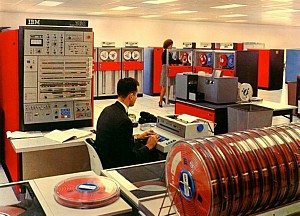Computer Science
Computing History Displays: Fourth Floor - Mainframe Computers
For 30 years, from the 1960s through the 1980s, serious computing was dominated by mainframe computers. These were large, heavy, and expensive - the name coming from the steel frame needed to carry the weight of the components. Mainframes typically occupied a very large air-conditioned room with a raised floor under which would be a "snake pit" of cables connecting the cabinets together. There was often just one mainframe provided for a whole institution.
The users of mainframes did not have direct access to the machines. Rather their work was punched onto cards, submitted to the computer centre, run by expert operators, then returned along with the print-out produced from compiling and running the program. Later users were able to access their mainframe from remote terminals using time-sharing.
Mainframes were not just machines but an approach to computing that provided an expensive bundle of support from the system vendor. Mini-computers and personal computers based on microprocessors showed that much routine computing could be much less expensive but mainframes continued because of their much higher performance and capacity. Mainframes were caught by exponential trends arising from continued progress in integrated circuits. Over time the performance of personal computers and work stations increased as microprocessors used denser and faster circuitry. And the cost of mainframe circuitry declined so that each processor got cheaper to make. This led to a crisis in the early 1990s that saw the end of mainframe manufacturers such as DEC and retrenchment by others.
However, mainframes did not go away. Nowadays they represent a much smaller fraction of total computing, with users interacting for most of their immediate needs with their workstation or PC. So mainframes are less visible but they have improved at historical rates and continue to provide services surrounding large databases. They tend to be called server clusters rather than mainframes but there are still rooms full of computers, some larger than ever.
There are three parts to our mainframe display:




